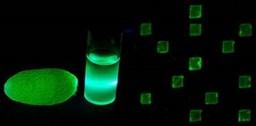
2 minute read
Fake Medications
From the ACS Press Room Edible, Fluorescent Silk Tags can Suss Out Fake Medications
“Edible Matrix Code with Photogenic Silk Proteins” ACS Central Science
Advertisement
Recent developments such as the explosion of online pharmacies and supply chain issues have made it easier for counterfeiters to profit from fake or adulterated medications. Now, researchers reporting in ACS Central Science have created edible tags with fluorescent silk proteins, which could be placed directly on pills or in a liquid medicine. The codes within the tags can be read by a smartphone app to verify the source and quality of these pharmaceuticals. Online pharmacies have taken off in recent years, delivering many types of medications directly to consumers’ homes. Some of these businesses are legitimate, but others operate illegally, supplying counterfeit drugs that are substandard, incorrectly labeled or laced with unwanted components. In addition, global supply chain problems have made it easy for fake medications to infiltrate the market. To instill trust in consumers, pharma companies label the outside packaging of their products with bar codes, QR codes, holograms and radio frequency identifiers, allowing distributors and retailers to manage products throughout the supply chain. Yet there aren’t equivalent codes for consumers to verify the source of individual pills or liquid doses inside a container. Researchers have developed fluorescent synthetic materials, such as microfibers and nanoparticles, as tracking codes, but the substances are potentially unsafe to consume. So, Seong-Wan Kim, Young Kim and colleagues wanted to see whether silk, which is an edible and “generally recognized as safe” material, could be placed directly onto medications and made to fluoresce, helping consumers make sure their purchases are what they claim to be. The researchers genetically modified silkworms to produce silk fibroins — edible pro-
teins that gives silk fibers their strength — with either a cyan, green or red fluorescent protein attached. They dissolved the fluorescent silk cocoons to create fluorescent polymer solutions, which they applied onto a thin, 9-mm-wide film of white silk in a seven-byseven grid. Shining blue violet, blue, and green light onto the grid revealed the 3D cyan, green and red square patterns, respectively. Using optical filters over the phone’s camera, an app the team designed can scan the fluorescent pattern, decoding the digitized key using a deep learning algorithm and opening up a webpage, which could host information about the drug’s source and authenticity. And Continued on page 15







